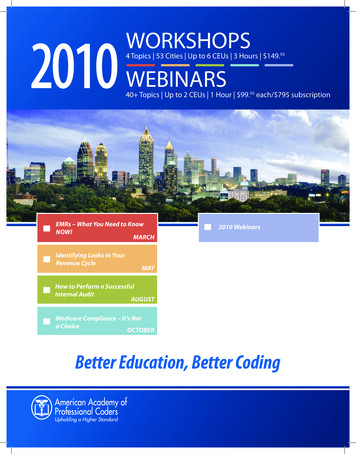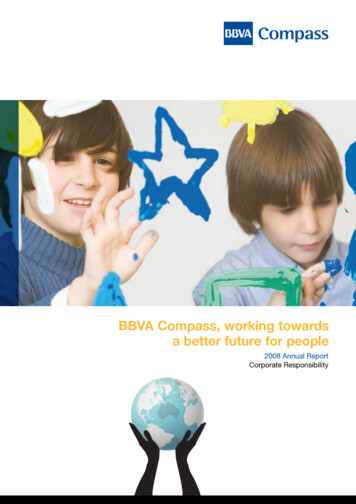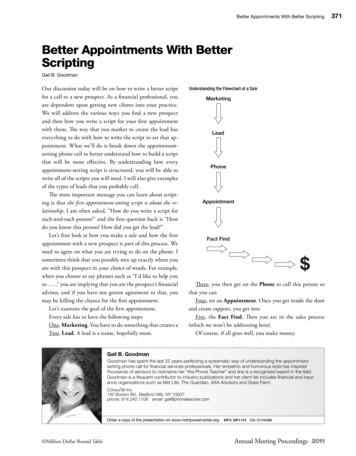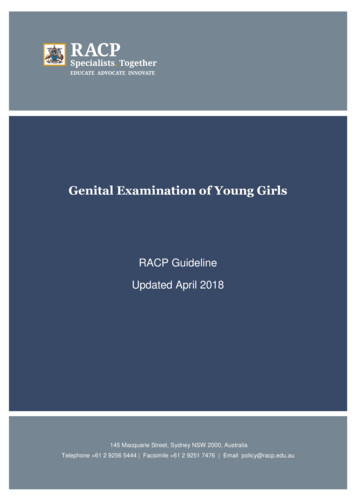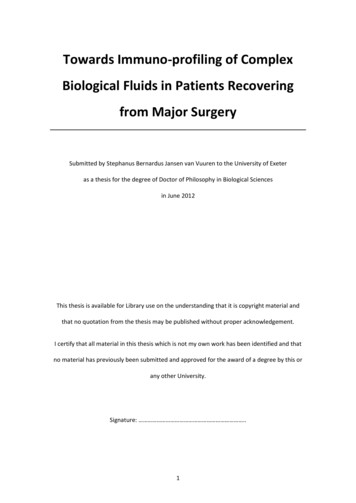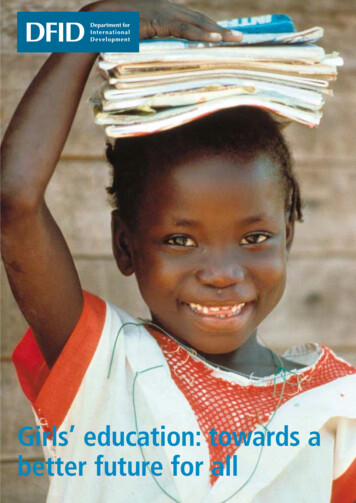
Transcription
Girls’ education: towards abetter future for all
Cover photo: A schoolgirl in Surinam. ( Ron Giling/Still Pictures)
Girls’ education: towardsa better future for allPublished by the Department for International DevelopmentJanuary 2005
ii
Forewordby the Secretary of State for International Development‘To be educated means I will not only be able to help myself, but also my family,my country, my people. The benefits will be many.’MEDA WAGTOLE, SCHOOLGIRL, ETHIOPIAAt the turn of the millennium, the international community promised that by 2005, there would beas many girls as boys in school. Later this year, when leaders from around the world come togetherto take stock of the Millennium Development Goals, there will be no escaping the fact that we havecollectively failed to keep this promise. Despite much progress, a child without an education is stillmuch more likely to be a girl than a boy.This strategy is a first step to get us back on track. It acknowledges that we all need to dosubstantially more to help girls get into school. It reminds us of the value of education for liftingnations out of instability and providing a more promising future to their people. And regardless ofwhether they live in a wealthy or poor country, nothing has as much impact on a child’s future wellbeing as their mother’s level of education.We do not need complex international negotiations to help solve the problem of education. We justneed to listen to governments, local communities, children, parents and teachers who know whatchallenges remain. And we need to provide them with enough funding to put their ideas oneducation into practice.To this end, we plan to spend at least 1.4 billion over the next three years. This money will provideadditional support to governments and more resources to strengthen international efforts to coordinate action on girls’ education.The example set by countries like Malawi, where the Minister for Education announced freeschooling and immediately increased enrolment rates, shows just what can be achieved when thereis a clearly defined plan of action and enough political will to implement it.In 2005, the UK will hold the Presidencies of the G8 and the EU. We will use our leadership role tomake achieving gender parity in education a priority for the international community.iii
Girls’ education: towards a better future for allAs Meda Wagtole’s words make clear, keeping our promise on girls’ education will not just give girlsbetter prospects; it holds the key to giving their families, communities and countries a better futureas well.Rt Hon Hilary Benn, MPiv
n matters2Education is a right – but it is still beyond the reach of many3A timely strategy4What prevents girls from getting a quality education?6Educating girls is costly for families7Girls may face a poor and hostile school environment92.3.4.5.Women have a weak position in society10Conflict hurts girls most11Tackling social exclusion11Tackling girls’ education on the ground12Political leadership and empowerment of women matter12Making girls’ education affordable15Making schools work for all girls17Charities, religious and other voluntary organisations are good for girls18Supporting policies that work19Focusing international efforts on girls’ education21More resources are needed21Donor actions in support of country-led development22International organisations need to work together for girls’ education23Civil society’s role in building global momentum and local support24Towards a better future for all27Annexes29Endnotes33v
vi
SummaryThere are still 58 million girls worldwide who are not in school. The majority of these girls live in subSaharan Africa and South and West Asia. A girl growing up in a poor family in sub-Saharan Africa hasless than a one-in-four chance of getting a secondary education. The Millennium Development Goal(MDG) to get as many girls as boys into primary and secondary school by 2005 is likely to be missedin more than 75 countries.We need to make much better progress. There is growing international commitment and consensuson what can be done to improve girls’ education. This strategy sets out the action DFID will take andthe leadership we will provide, with others in the international community, to ensure equality ofeducation between men and women, boys and girls. We will work to narrow the financing gap for education. Over the next three years, DFID plansto spend more than 1.4 billion of aid on education. We will work with the United Nations Children’s Fund (UNICEF) to strengthen its capacity toco-ordinate action on girls’ education. We will use the UK’s Presidencies of the G8 and EU and our role as co-chair of the Fast-TrackInitiative (FTI) to push gender equality in education up the political agenda. We will support the efforts of governments in developing countries to produce plans thatprioritise girls’ education. This will include providing financial help to those wanting to removeschool fees. We will work with our development partners to increase educational opportunities for girls;civil society will be a key partner in this work. We will increase our efforts to promote awareness within the UK of girls’ education inpoor countries.Educating girls helps to make communities and societies healthier, wealthier and safer, and can alsohelp to reduce child deaths, improve maternal health and tackle the spread of HIV and AIDS. Itunderpins the achievement of all the other MDGs. That is why the target date was set as 2005. Thatis also why in 2000, at the Dakar Conference, donors promised that every country with a soundeducation plan would get the resources it needed to implement it.Progress has been hampered by a number of factors: a lack of international political leadership, aglobal funding gap of an estimated 5.6 billion a year for education, a lack of plans and capacitywithin national education systems to improve the access to and quality of schooling for girls, andlocally many poor families who simply cannot afford to send their children to school.This paper marks a new phase in the UK’s support to girls’ education.Now is the time to act.1
1Chapter OneIntroductionEducation mattersIn September 2000, 188 heads of state from around the world signed the Millennium Declarationand established the Millennium Development Goals (MDGs). While most goals aim to achievesignificant progress in development by 2015, one goal was to be achieved by 2005 – gender parityin primary and secondary education. But, more than 75 countries are likely to miss this goal. We arefalling well short of our promise.Women are at the heart of most societies. Regardless of whether they are working or not, mothers arevery influential people in children’s lives. Educating girls is one of the most important investmentsthat any country can make in its own future.Education has a profound effect on girls’ and women’s ability to claim other rights and achievestatus in society, such as economic independence and political representation. As the followingexamples demonstrate, having an education can make an enormous difference to a woman’schances of finding well-paid work, raising a healthy family and preventing the spread of diseasessuch as HIV and AIDS.A South African girl at her high schoolgraduation. ( Giacomo Pirozzi/Panos) 2 Women with at least a basic education are much lesslikely to be poor. Providing girls with one extra year ofschooling beyond the average can boost their eventualwages by 10 to 20 per cent.1 An infant born to an educated woman is much morelikely to survive until adulthood. In Africa, children ofmothers who receive five years of primary educationare 40 per cent more likely to live beyond age five.2 An educated woman is 50 per cent more likely to haveher children immunised against childhood diseases.3 If we had reached the gender parity goal by 2005,more than 1 million childhood deaths could have beenaverted.4For every boy newly infected with HIV in Africa, there are between three and six girls newlyinfected. Yet, in high-prevalence areas such as Swaziland, two-thirds of teenage girls in schoolare free from HIV, while two-thirds of out-of-school girls are HIV positive. In Uganda, childrenwho have been to secondary school are four times less likely to become HIV positive.5
IntroductionEducation is a right – but it is still beyond the reach of manyFor all these reasons, girls’ education has long been recognised as a human right. Past internationalcommitments include addressing gender equality within the education system, the first step toeliminating all forms of discrimination against women (see Annex 2).This right to education is denied to 58 million girls, and a further 45 million boys, even at the primaryschool level.6 More than 75 countries are likely to miss the 2005 MDG target for gender parity inprimary and secondary enrolments.7 One-third of these countries are in sub-Saharan Africa. Oncurrent trends, more than 40 per cent of all countries with data are at risk of not achieving genderparity at primary, secondary or both levels of education even by 2015.Figure 1.1: Prospects for gender parity in primary enrolmentsProgress towards the targetGender parity in primary enrolmentsAt risk of not achieving by 2015Likely to achieve by 2015Likely to achieve by 2005Achieved in 2000(20)(14)(13)(78)Source: Education for All Global Monitoring Report 2003-04. Grey shading indicates lack of data.These figures hide significant variation across continents, across countries, and across communities. There are 23 million8 girls out of school in sub-Saharan Africa, distributed across more than 40countries. A further 22 million out-of-school girls are in South and West Asia, yet the majorityof these are concentrated in just two countries: India and Pakistan. In Niger, less than one-third of all school-aged girls are enrolled in primary school. By contrast,in Rwanda more than four out of every five girls are enrolled in primary school. In Mali, the proportion of girls enrolled in primary school is around six times higher in the cityof Bamako than in the more remote areas of Mali.3
1Girls’ education: towards a better future for allThere is an alarming difference between the numbers of girls attending primary and secondaryschool. The vast majority of school-aged girls in sub-Saharan Africa are not enrolled in secondaryschool, because the relatively high costs of secondary education are acting as a major disincentivefor poorer parents. In Pakistan, the gross enrolment rate for girls in secondary education is 19 percent.9 In Niger, Tanzania and Chad it is only five per cent. There are exceptions to the rule, butgenerally in countries where girls fare poorly in primary education compared with boys, they do evenworse in secondary education, as illustrated by the graph in Annex 3.Nevertheless, countries are making progress, sometimes dramatically so. In Bangladesh, equal numbers of girls and boys now enter secondary school. In 1990, therewere only half as many girls as boys in secondary education. Nepal has nearly nine girls for every ten boys enrolled in primary school, compared with sevengirls for every ten boys in 1990. In Kenya, over 1 million extra children have enrolled in primary school since the removal ofschool user fees in 2003.A timely strategyThis paper is a first step to identifying – and implementing – the actions that will allow uscollectively to keep the promises we made.10 It serves as a reminder for us to speed up the work weare doing in education. Examples of our work in education include: Supporting education in Nigeria where there are 7.3 million children of primary age out ofschool, of whom 62 per cent are girls.11 The federal Ministry of Education in Nigeria isimplementing an education programme with support from UNICEF and DFID to achieve genderparity and universal basic education. DFID is providing a 26 million grant, which will directlybenefit girls as well as boys in six northern states. Allocating 10.8 million to the government of Kenya initiative SPRED III (Strengthening ofPrimary Education), which aims to reduce the burden of the cost of primary education onparents. In the first year of this programme, enrolments increased from 5.9 million to over7 million and are still rising.Listening to local people has been an invaluable way of identifying the main constraints that keepgirls from entering school, remaining in school, and learning effectively. Our country experience isalso providing us with concrete evidence of how governments are overcoming these challenges. Weare using this evidence of what works as the basis for the actions we intend to take to speed upprogress on girls’ education.4
IntroductionDFID’s experience in tackling girls’ education is drawn from the 25 priority countries where our workis focused. Our education effort in these countries is aimed at supporting governments to provideeducation for all, particularly for girls. These 25 countries contain nearly three-quarters of all girlswho do not have access to basic education as shown in Figure 1.2.Global support for development, while on the rise, remains well below what is needed to makeachieving the MDGs a reality, particularly in countries that are unable to work towards povertyreduction. International bilateral support for education amounts to about 4 billion a year, withmuch of this money going towards secondary and university schooling. International support forbasic education is less than 1 billion a year – less than 2 a year for every school-aged child inthe developing world. We need to do better. And we can do better.Figure 1.2: Distribution of girls out of school in DFID’s 25 priority countriesOutside DFID’s 25priority countries28%DFID’s 25priority weZambiaVietnamSouth AfricaNepalMozambiqueGhanaDRC, Nigeria, Sierra Leone,Uganda (separate datanot ted Republicof TanzaniaAfghanistanChinaEthiopia5
2Chapter TwoWhat prevents girls from getting a quality education?In many countries and communities in both the developed and the developing world, parents cantake it for granted that their daughters receive a quality education. Yet in many other places aroundthe world, providing every child with an education appears to be beyond reach.There are five main challenges we identify that make it difficult for girls to access education.These include: the cost of education – ensuring that communities, parents and children can afford schooling; poor school environments – ensuring that girls have access to a safe school environment; the weak position of women in society – ensuring that society and parents value the educationof girls; conflict – ensuring that children who are excluded due to conflict have access to schooling; and social exclusion – ensuring girls are not disadvantaged on the basis of caste, ethnicity, religionor disability.These challenges are not exhaustive, but they are recurrent themes in many countries. They constituteadditional hurdles girls need to overcome to benefit from quality education.As donors, we need to support countries in meeting these challenges. Ours is a supporting role, not aleading role. And our support works best if it is based on countries’ own national strategies toreduce poverty and make progress in education. In particular we need to support countries to havein place the essential elements of quality education for girls (see Box 2.1).6
What prevents girls from getting a quality education?Box 2.1Essential elements of quality education for girls Schools – is a school within a reasonable distance; does it have proper facilities forgirls; is it a safe environment and commute; is it free of violence? If not, parentsare unlikely to ever send their daughter to school. Teachers – is there a teacher; are they skilled; do they have appropriate teachingmaterials? Is it a female teacher? Are there policies to recruit teachers fromminority communities? If not, girls may not learn as much at school and drop out. Students – is she healthy enough; does she feel safe; is she free from the burden ofhousehold chores or the need to work to supplement the family income; is there awater source close by? If not, she may never have a chance to go to school. Families – does she have healthy parents who can support a family; does her familyvalue education for girls; can her family afford the cost of schooling? If not,economic necessity may keep her at home. Societies – will the family’s and the girl’s standing in the community rise with aneducation; will new opportunities open up? If not, an education may not be in thefamily’s interest. Governments – does the government provide adequate resources to offersufficient school places; do salaries reach the teachers; do teachers receive qualitytraining; is the government drawing in other agencies to maximise the provision ofschooling; is there a clear strategy and budget based on the specific situation facedby girls? If not, the conditions above are unlikely to be fulfilled. Donors – are donors supporting governments to provide adequate resources; dodonors contribute to analysing and addressing the challenges girls face; are donorsconscious of local customs and traditions; are donors prioritising the countries’needs rather than their own agendas or existing programmes? If not, governmentsmay simply not be in a position to provide a reasonable chance for all girls to get aquality education.Educating girls is costly for familiesThe education of girls is seen as economically and socially costly to parents. Costs come in fourforms: tuition fees and other direct school fees; indirect fees (such as PTA fees, teachers’ levies andfees for school construction and building); indirect costs (such as transportation and uniforms); andopportunity costs (such as lost household or paid labour). These costs have a significant impact onwhether and which children are educated.7
2Girls’ education: towards a better future for allEducating girls can incur extra direct costs, such as special transport or chaperones for safety and‘decency’. The price of attending school for the 211 million economically active children may be thefamily losing vital income.12 An education may actually reduce girls’ marriage prospects and raisedowry payments to unaffordable levels. Investing in sons, rather than daughters, is perceived asbringing higher financial returns for families as boys are more likely to find work and be paid ahigher salary.The high cost of education is the biggest deterrent to families educating their daughters.Many of the countries DFID prioritises for support have removed tuition fees or are working towardstheir removal. For example, there are no tuition fees in our Asia priority countries except Pakistan,and a number of Africa priority countries have recently removed school fees. In Africa, school feeremoval has led to a dramatic increase in enrolments.A girl does her homework on the blackboard painted on the wall of her house in Ghana. Her older sister, withbaby on her back, checks her exercise book. ( Sven Torfinn/Panos)But it has also increased the cost of education for governments. For example, in Uganda, it isprojected that there will be a 58 per cent increase in the total number of primary school studentsbetween 2002 and 2015, requiring more than double the number of teachers. Given that teachers’salaries are the single biggest cost in education budgets, this represents a high burden. Mostgovernments have increased both their education budget and the share that is allocated to primaryeducation to finance these extra costs. But the challenge remains to find enough money to sustainan education of sufficient quality – while simultaneously reducing other costs that prevent childrenfrom poor families, especially girls, from enrolling.8
What prevents girls from getting a quality education?Box 2.2AIDS – making the household economics worseGirls are often the first to be taken out of school to provide care for sick familymembers or to take responsibility for siblings when death or illness strike.13 A suddenincrease in poverty, which accompanies AIDS in the household, undermines the abilityto afford school. The fear of infection through abuse or exploitation in or on the way toschool particularly affects girls and may reduce attendance. Orphans seem to be atgreater risk of exploitation. In the worst cases, girls may resort to prostitution toprovide for themselves and the family. In Zambia, the majority of child prostitutes areorphans, as are the majority of street children in Lusaka.14 Programmes of support areoften not targeted to these most vulnerable groups.Girls may face a poor and hostile school environmentA school environment that may be acceptable to boys may be hostile to girls. The physical and sexualviolence against women that is common in many societies is reflected in the school environment in anumber of countries. Physical abuse and abduction are not only a major violation of girls’ basichuman rights, they also present a major practical constraint in getting to school. Parents feel a dutyto protect their daughters and may decide to keep them at home if they feel the school is too faraway. Violence against girls and women has been identified as a key barrier to girls’ education inmany DFID programmes. In South Africa, DFID supports Soul City, an educational television soapopera that raises public awareness of violence against girls and women.Within developing countries, better recruitment procedures and working conditions need to beadopted to help increase the number of women teachers, who often become important role modelsfor the young women they teach. Teachers need training to be effective in supporting girls and tointervene when violence is threatened. When teachers themselves perpetrate violence, early responsesystems need to be implemented to prevent such violence continuing. Alongside training to combatall forms of discrimination in the classroom, there needs to be an effective monitoring and inspectionsystem that engages teachers, especially where there are violations of teacher authority.Governments also need more education officials and teachers who have the knowledge,understanding and status to ensure that girls have access to quality education.15 Expertise isrequired to assess the problems and solutions for the education system according to the countrycontext and real need, rather than the trends of the development agencies.9
2Girls’ education: towards a better future for allWomen have a weak position in societyWithin communities, girls have to overcome many obstacles before they can realise their right to aneducation. DFID’s recent partnership with UNICEF to support the federal government of Nigeria willhelp overcome many of the problems girls have in gaining access to school and remaining there.Before girls can attend school and benefit fully from their education, a number of major socialconstraints have to be addressed.Girls often have limited control over their futures. Early marriage is a reality for many, where familieswish for the social and economic benefits this brings. In Bangladesh and Afghanistan, more than 50per cent of girls are married by age 18.16 Adolescent pregnancy almost always results in girls haltingtheir education. Girls are also more likely to drop out of school because of their domesticresponsibilities, and are often discriminated against in terms of the quality of the schools they aresent to, and the costs parents are willing to pay for their education.Despite the progress being made, gender equality is likely to take generations to achieve. The UK’sown history illustrates the relationship between women’s position in society and the demands forbetter education for girls. One reinforces the other, but change comes slowly.Box 2.3Progress on gender equality in education in the UKUntil the 1960s, many British girls were directed towards the commercial and technicalstreams in secondary school, and did not acquire qualifications for higher payingemployment. Until the mid-1980s, for instance, it was still relatively unusual for girls todo well in or continue studying subjects such as mathematics or science to universitylevel. However, the 1990s saw a sharp rise in girls’ performances at school. This hasbeen linked to a range of factors, including families’ prioritisation of their daughters’education, a shift in perceptions of gender linked to the women’s movements in the1960s and 1970s, government policies on comprehensive schools, promoting furthereducation and reform of the exam system and gender equality strategies in localeducation authorities and schools. Policies such as, areas in schools just for girls, stronganti-bullying and anti-harassment policies, and the promotion of science andmathematics for girls were put in place. In addition, growth in the service sectorfacilitated demand for girls in the labour market. Currently there is concern about whyimproved academic performance for girls has not translated into equality inemployment opportunities and earning power.1710
What prevents girls from getting a quality education?Conflict hurts girls mostGirls are particularly vulnerable to abuse and unequal access to schooling in fragile states. States canbe fragile for a range of reasons, including conflict, lack of resources and people, high levels ofcorruption, and political instability. What sets these countries apart is their failure to deliver on thecore functions of government, including keeping people safe, managing the economy, and deliveringbasic services. Violence and disease, as well as illiteracy and economic weakness, are mostintensively concentrated in these areas. Of the 104 million children not in primary school globally, anestimated 37 million of them live in fragile states. Many of these children are girls.18Girls’ absence from school may be due to fears of violence or due to the reliance on their role ascarers in the family. In Rwanda, for example, it is estimated that up to 90 per cent of child-headedhouseholds are headed by girls.19 For girls who have been victims of violence in conflict situations,trauma can impair their ability to learn. More than 100,000 girls directly participated in conflicts inthe 1990s, yet they are often invisible in demobilisation programmes.20Our humanitarian support and education support programmes in Rwanda have demonstrated theimportance of education in promoting peace and protecting human resources in countries emergingfrom conflict. Our work in these environments is a reminder of the need to link education withattempts to build democracy, provide better health systems, offer social protection to the verypoorest and develop multilingual and multicultural policies.Tackling social exclusionSocial exclusion is an additional barrier to girls going to school. Certain groups of girls are morelikely to be excluded from school on the basis of caste, ethnicity, religion or disability. In Nepal, Dalitgirls are almost twice as likely to be excluded from school as higher caste girls. In Malawi, Muslimgirls are more likely to be excluded than their non-Muslim counterparts. Disabled children, andamong them disabled girls in particular, constitute a significant group that is denied access toeducation. In a recent World Bank report it is estimated that only about 1-5 per cent of all disabledchildren and young people attend schools in developing countries.21At the World Conference on Special Education Needs in Salamanca, 92 countries and 25international organisations committed themselves to providing educational opportunities for disabledpeople. The challenge is to support governments to act on this commitment, and provide qualityeducation for excluded groups. In India we have worked with the government to address socialexclusion in the government of India’s SSA (Education for All) plan.11
3Chapter ThreeTackling girls’ education on the groundAs outlined in the previous chapter, countries wanting to develop and implement a policy ofpromoting girls’ education face a number of challenges. But for every challenge, there are examplesof promising good practice that should form the basis of the way ahead.DFID will support governments to: strengthen political leadership and empower women; make girls’ education affordable; and make schools work for all girls.We will also support NGOs, religious and other voluntary organisations.This support will enable governments to develop poverty reduction strategies and education sectorplans to improve girls’ access to quality education. And we will provide increased and flexiblefunding to support the development and implementation of national plans.22DFID’s bilateral funding commitments for basic education averaged at 150 million a year up to 2001.Since the World Education Forum at Dakar and the Millennium Summit in 2000, the UK has significantlyincreased its new commitments for education programmes and we will continue to do so. As a result,we expect to spend an average of 350 million a year on education (a total of over 1 billion) over theperiod 2005-06 to 2007-08. This would roughly double the resources going directly to educationprogrammes in developing countries since we first adopted the MDGs. In addition to our bilateralcontributions, we expect to spend 370 million through multilateral agencies, bringing our total fundingfor education over the next three years to over 1.4 billion.23Political leadership and empowerment of women matterWe will support governments in their efforts to create political leadership for women’sempowerment. We know that national leaders who speak out against gender inequality can have asignificant impact. Heads of government in Oman, Morocco, China, Sri Lanka and Uganda havea
Saharan Africa and South and West Asia.A girl growing up in a poor family in sub-Saharan Africa has less than a one-in-four chance of getting a secondary education.The Millennium Development Goal (MDG) to get as many girls as boys into primary and secondary school
